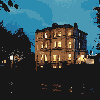Greetings all, I am going to be performing a version of Echoes soon with my band at a Coffeehouse for school, and I need some help with the piano setup. I have my digital keyboard running through my PODLiveXT (which allows me the perfect Floyd sound, btw), and with the Leslie Rotating Cab modeled, and just about the correct reverb. However, though it sounds damn close to the album, there seems to be a sharp falloff in sustain and volume with the higher octaves (such as the constant B ping, and higher arpeggios), and I was wondering if Rick used any slight distortion, tube preamp, or compressor to warm up and fatten the sound? From the Live at Royal Albert Hall DVD, I cant see anything he is running his keyboard into, and in all likelihood he has simply modeled the sound into his keyboard, so I was wondering if anyone out there knew if, say, he ran the mic'd piano though, say, a Dynacomp or turned down Colorsound Power Boost or anything like that. I have spent at least 8 hours experimenting myself, so any further help in this area would be appreciated.
Thanks
(Am I the only one here who wishes there was a Wrightish website to go along with Gilmourish?)
Echoes Piano Help
-
nemesis11f

- Blade

- Posts: 172
- Joined: Wed Jul 06, 2005 1:34 am
- Location: Insignificant Maryland
-
bpmolder

- Lord!!

- Posts: 4393
- Joined: Sun May 11, 2003 2:52 am
- Location: The State Of Peace!
Re: Echoes Piano Help
Any time you have a sample-based synth running live, you are going to run into attenuation at the higher frequencies due to the simple fact that you absolutely cannot match the timbre of a real grand piano. As a result, with increased volume, the lower notes will sound just fine as long as you don't trigger more than three sample sounds simultaneously. The higher notes, however, will always sound like shit. Rick Wright didn't have that problem live because he played a real grand piano into a real Leslie, closely duplicating the effect he achieved on the recording.
Here's what you do to compensate for these things:
1. Set the high range on your PA mixer EQ to about 6 to 8 kHz. This will help cut out part of the high frequency differential noise from multiple samples being played over one another.
2. Use a plate or digital reverb and set it to about 10 to 20 dry. Set the predelay to between 100 and 200 ms depending on the size of room you will be playing in. You will have to feel your way through it on the sound check.
3. Apply compression to the output before the Leslie effect, at about a 1.5:1 ratio, with a threshold of -11dB and bump the output up to +3dB.
4. Tweak the Leslie effect so the balance between the tweeter and woofer are a little more on the bass side.
These things should fatten up your pinging sound. The problem is that when working with digital samples, there is an attenuation when triggering two or more samples simultaneously. That attenuation is increased by improper Leslie setup. So by taking the higher frequencies out, at 8kHz and above, that will remove part of the imperfections. The reverb effect will scatter the noise that can't be removed, and the compression will smooth the dynamics somewhat and boost the volume back up, enabling you to get back the clean part of the signal that was lost with the high band cuts. Setting the Leslie up correctly will create a proper balance for the sound output that will be heard. Proper Leslie setup is really difficult to do and is pretty much a lost, "old school" art.
Your VST effects should be able to handle all of these things through your software without necessitating any new equipment.
Here's what you do to compensate for these things:
1. Set the high range on your PA mixer EQ to about 6 to 8 kHz. This will help cut out part of the high frequency differential noise from multiple samples being played over one another.
2. Use a plate or digital reverb and set it to about 10 to 20 dry. Set the predelay to between 100 and 200 ms depending on the size of room you will be playing in. You will have to feel your way through it on the sound check.
3. Apply compression to the output before the Leslie effect, at about a 1.5:1 ratio, with a threshold of -11dB and bump the output up to +3dB.
4. Tweak the Leslie effect so the balance between the tweeter and woofer are a little more on the bass side.
These things should fatten up your pinging sound. The problem is that when working with digital samples, there is an attenuation when triggering two or more samples simultaneously. That attenuation is increased by improper Leslie setup. So by taking the higher frequencies out, at 8kHz and above, that will remove part of the imperfections. The reverb effect will scatter the noise that can't be removed, and the compression will smooth the dynamics somewhat and boost the volume back up, enabling you to get back the clean part of the signal that was lost with the high band cuts. Setting the Leslie up correctly will create a proper balance for the sound output that will be heard. Proper Leslie setup is really difficult to do and is pretty much a lost, "old school" art.
Your VST effects should be able to handle all of these things through your software without necessitating any new equipment.
